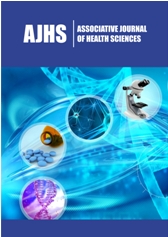- Submissions

Full Text
Associative Journal of Health Sciences
Challenges and Progress in Ivermectin-Based Treatment of Onchocerciasis in Nigeria: A Path Towards Elimination
Akanni John Olajide*1,2
1Department of Mathematics, Universitas of Airlangga, Indonesia.
2Mathematical Institute and Big Data Institute, Nuffield Department of Medicine, University of Oxford, United Kingdom
*Corresponding author:Akanni John Olajide, Department of Mathematics, Universitas of Airlangga, Indonesia. Mathematical Institute and Big Data Institute, Nuffield Department of Medicine, University of Oxford, United Kingdom
Submission: August 23, 2024;Published: October 18, 2024

ISSN:2690-9707 Volume3 Issue4
Abstract
Nigeria bears a substantial burden of onchocerciasis, a disease caused by the filarial worm Onchocerca volvulus and transmitted by blackflies. This report reviews the effectiveness of ivermectin-based mass drug administration (MDA) in treating the disease, highlighting significant reductions in prevalence. However, challenges like uneven treatment coverage, risks of ivermectin resistance, and complications in co-endemic areas with loiasis persist. The report emphasizes the importance of continuous community engagement, exploration of alternative treatments like doxycycline, and integrated health programs to overcome these barriers and work towards the eventual elimination of onchocerciasis in Nigeria.
Keywords:Nigeria bears; Onchocerca volvulus; Infected blackflies
Introduction
Onchocerciasis, commonly known as river blindness, is a parasitic disease caused by the filarial worm Onchocerca volvulus and is transmitted to humans through the bite of infected blackflies (Simulium species). Nigeria is one of the most affected countries globally, accounting for a significant portion of the disease’s global burden. The disease manifests as severe itching, skin rashes, nodules under the skin, and, in severe cases, blindness. Effective treatment and control strategies are vital in reducing the disease’s prevalence and mitigating its socio-economic impact in Nigeria.
Treatment strategies
The primary treatment for onchocerciasis in Nigeria is through mass drug administration (MDA) of ivermectin (Mectizan). Ivermectin is a microfilaricide that kills the larval stages of the parasite (microfilariae), thereby reducing the intensity of the infection and halting transmission. The World Health Organization (WHO) recommends annual or bi-annual ivermectin distribution in endemic areas as a control strategy. Nigeria has implemented this approach through the African Programme for Onchocerciasis Control (APOC) and later the Expanded Special Project for Elimination of Neglected Tropical Diseases (ESPEN) [1].
The success of ivermectin distribution in Nigeria has been significant, with many communities reporting reduced transmission rates and a decline in disease prevalence. However, the treatment requires continuous administration for at least 10-15 years, corresponding to the lifespan of adult worms. Thus, the program’s sustainability is crucial for achieving long-term disease elimination.
Challenges in treatment
Despite the success of ivermectin MDA, several challenges
persist in Nigeria’s fight against onchocerciasis:
A. Coverage gaps in remote and conflict-affected areas
hinder the effective distribution of ivermectin, leaving some
populations untreated.
B. Although not yet confirmed, the emergence of ivermectin
resistance poses a potential threat to the drug’s long-term
efficacy.
C. Community compliance with the treatment program is
sometimes low due to misinformation, fear of side effects, and
socio-cultural factors.
Another challenge is the co-endemicity of onchocerciasis with loiasis caused by the Loa loa worm. In areas where both diseases are present, administering ivermectin can lead to severe adverse reactions, including encephalopathy, in individuals with high levels of Loa loa microfilariae. This co-infection complicates treatment efforts, requiring careful screening and monitoring [2].
Prospects and recommendations
Several strategies can be recommended to overcome these challenges. Strengthening community engagement and education programs can improve compliance and address misinformation. Expanding access to treatment in hard-to-reach areas through innovative delivery mechanisms, such as mobile clinics and community-directed interventions, can help close coverage gaps. Moreover, research into alternative treatments, such as doxycycline, which targets the symbiotic bacteria (Wolbachia) within O. volvulus, offers a promising avenue for future control strategies [3].
Integrating onchocerciasis treatment with other neglected tropical disease programs can also enhance efficiency and reduce costs. For instance, combining ivermectin distribution with treatments for lymphatic filariasis and soil-transmitted helminths could improve overall health outcomes in endemic communities [4].
Conclusion
The treatment of onchocerciasis in Nigeria has made remarkable progress through the widespread use of ivermectin, yet challenges that require sustained efforts and innovative approaches remain. Addressing the issues of treatment coverage, resistance, and co-endemicity with other diseases is crucial for the goal of onchocerciasis elimination. Continued collaboration between government agencies, non-governmental organizations, and affected communities will be essential in achieving a future free of onchocerciasis in Nigeria.
References
- World Health Organization (2022) Onchocerciasis. Geneva, Switzerland.
- African Programme for Onchocerciasis Control (APOC) (2015) Progress report on the elimination of onchocerciasis in Nigeria.
- Boussinesq M, Gardon J, Gardon Wendel N, Chippaux JP (2003) Management of Loa loa and mectizan serious adverse events related to onchocerciasis treatment. Filaria Journal 2(Suppl 1): S8.
- Tekle AH, Elhassan E, Isiyaku S, Amazigo UV, Bush S, et al. (2012) Impact of long-term treatment of onchocerciasis with ivermectin in Kaduna State, Nigeria: First evidence of the potential for elimination in the operational area of the African Programme for Onchocerciasis Control. Parasites & Vectors 5: 28.
© 2024 Akanni John Olajide. This is an open access article distributed under the terms of the Creative Commons Attribution License , which permits unrestricted use, distribution, and build upon your work non-commercially.
 a Creative Commons Attribution 4.0 International License. Based on a work at www.crimsonpublishers.com.
Best viewed in
a Creative Commons Attribution 4.0 International License. Based on a work at www.crimsonpublishers.com.
Best viewed in 







.jpg)






























 Editorial Board Registrations
Editorial Board Registrations Submit your Article
Submit your Article Refer a Friend
Refer a Friend Advertise With Us
Advertise With Us
.jpg)






.jpg)














.bmp)
.jpg)
.png)
.jpg)










.jpg)






.png)

.png)



.png)






